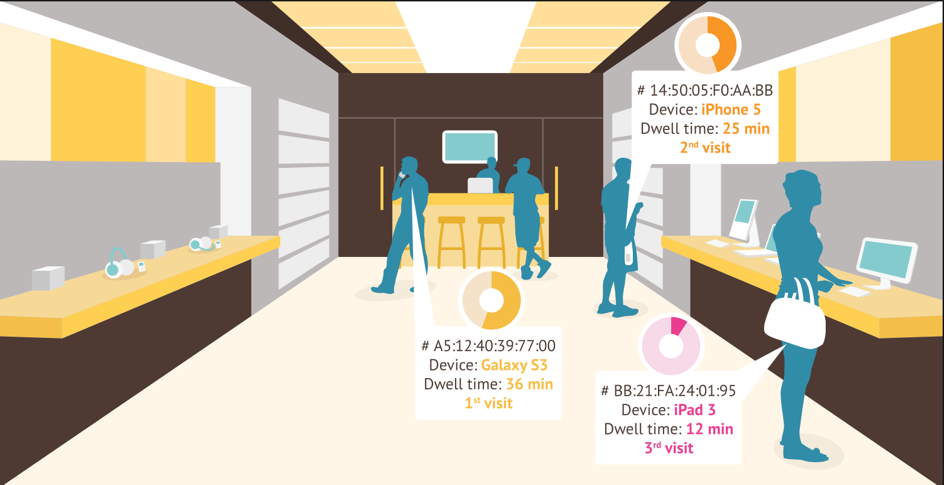Until recently, the positioning process of products (product placement) in a store depended almost exclusively on plain (commercial) intuition. There wasn’t a solid way to predict and/or measure which grouping of products would be the most profitable. Questions like, should we put the beer next to other alcoholic beverages, or is it more profitable to put it next to the diaper department, could not be answered straight-away and/or supported by facts. And another one: what are the peak hours of our store in receiving the most visitors/prospects during the day, so we can adjust our personnel based on those fluctuations? Since a couple of years, there is a low-tech solution to answer those questions: Wi-Fi tracking.
The technique of Wi-Fi tracking is based on the fact that mobile phones are emitting signals constantly. Mobile phones do not wait in a passive state until a public network found them to connect with, but they are emitting signals to actively search for those public networks. When searching for a local Wi-Fi network, the mac-address of each phone is emitted. Each mac-address is unique for a mobile device and, in most cases, a mobile device is unique for one person. How can this simple technology feature be transformed into an information goldmine? Multiple start-ups have found different ways to monitor these mac-addresses with specialized hardware and software. Raw data emitted by you is processed using advanced software to deliver meaningful information to the store about your behaviour on the spot. And the store is able to adjust their commercial offerings to you: your own, involuntary provided, information is used against you. Therefore, it is interesting for stores and other instances to possess and use your information to increase their revenue.
Wi-Fi Tracking isn’t only beneficial for stores only, it is used by other types of organizations as well, although for other purposes. Cities, event organizers, and amusement parks also measure, store, and use mac addresses to gather customer insights. For instance, they use this technique to convert movements of large crowds into flow mappings, on which you can see how customers walk and where they spend the most time (and money, when linked to point-of-sale data). As you might imagine, this can lead to great insights in logistics, consumer behaviour, and how and where to increase revenue.
But is this legal? The answer is yes, even though there is a lot of debate going on about this subject. However, some limitations apply. When individuals are being followed in a store, the data can be saved for a maximum of 24 hours. After that period the data must be directly destroyed or irreversibly be made anonymous. Can you fight and prevent this “involuntary data loss”?
Consumers, like you and me, still possess a very powerful weapon to fight this unsolicited tracking of Wi-Fi signals: simply turning off our Wi-Fi should do the trick!
Unfortunately, the ugly truth is that a lot of people aren’t aware that they are tracked in this way nor that they care about their privacy enough to prevent this. If it is invisible, it is not happening, right? No, wrong! It is happening, every day, every hour, every minute, by everybody, anywhere.
References
Sapiezynski P, Stopczynski A, Gatej R, Lehmann S (2015) Tracking Human Mobility Using WiFi Signals. PLoS ONE 10(7): e0130824.
http://journals.plos.org/plosone/article?id=10.1371/journal.pone.0130824

